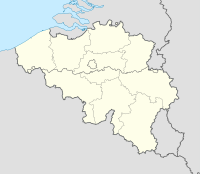| Battle of Dinant | |||||||
|---|---|---|---|---|---|---|---|
| Part of the Battle of Charleroi during the Battle of the Frontiers in the First World War | |||||||
 The town of Dinant before and after the battle and massacres | |||||||
| |||||||
| Belligerents | |||||||
|
|
| ||||||
| Commanders and leaders | |||||||
| Henry Victor Deligny | Max von Hausen | ||||||
| Units involved | |||||||
| Fifth Army | 3rd Army | ||||||
| Casualties and losses | |||||||
| 1,100–1,200 killed and wounded | 4,275 killed and wounded | ||||||
| c. 674 Belgian civilians massacred | |||||||
The Battle of Dinant was an engagement fought by French and German forces in and around the Belgian town of Dinant in the First World War, during the German invasion of Belgium. The French Fifth Army and the British Expeditionary Force (BEF) advanced into Belgium and fought the Battle of Charleroi (21–23 August) and Battle of Mons (23 August), from the Meuse crossings in the east, to Mons in the west. On 15 August 1914, German troops captured the Citadel of Dinant which overlooked the town; the citadel was recaptured by a French counter-attack during the afternoon.
French troops spent the next few days fortifying the Meuse crossings and exchanging fire with German troops on the east bank. A German raiding-party drove into Dinant on the night of 21/22 August but the attack degenerated into a fiasco, in which Germans may have fired at each other. Rather than consider that the small-arms fire may have come from the French troops on the west bank, the German soldiers blamed Belgian civilians, killing seven and burning down 15 to 20 houses in reprisal. The raiders withdrew having suffered 19 dead and 117 wounded.
On 23 August, the Germans attacked Dinant again, under the impression that the town was full of francs-tireurs (civilian irregular forces, who were defined as terrorists under German military law). German troops of the 3rd Army massacred 674 unarmed Belgian civilians while fighting French troops, who were still dug in along the west bank and on the east end of the bridge. The massacre was another reprisal against anticipated civilian resistance and was the largest of the German war crimes perpetrated during the invasion, which became collectively known as the Rape of Belgium.
